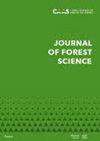乌克兰喀尔巴阡山脉徒步小径上的云杉林凋落物结构、分布和保水能力
IF 1.1
Q3 FORESTRY
引用次数: 1
摘要
由于其生态价值和对众多游客的吸引力,乌克兰喀尔巴阡山脉生态系统的近24%被分配给保护基金。山林林分的凋落物在减轻旅游活动和侵蚀过程的影响以及对土壤矿化的贡献方面发挥着重要作用。森林凋落物的截留、入渗和截留能力影响着森林生态系统的水文过程。同时,凋落物的积累和空间分布不仅受到环境条件的影响,还受到旅游的影响。在这项研究中,选择了13个挪威云杉(Picea abies L.)林分,通过与步道的平均距离来区分,研究在乌克兰喀尔巴阡山脉的热门徒步小径沿线地区,凋落物结构、保水能力、渗透能力以及凋落物积累是否存在差异。结果表明,凋落物厚度随海拔和坡度的增加而增加。此外,单因素方差分析结果显示,两组样地的凋落物存量差异显著(P < 0.05):直接建立在毗邻徒步旅行路线的样地和距离较远的样地。因此,徒步小径附近的森林凋落物存量可能表明游客的踩踏对凋落物积累有负面影响。但是,各林分凋落物累积量在不同海拔和不同路径上均无统计学差异(P > 0.05)。浸没试验结果表明,凋落物入渗速率与最大吸水质量(r = -0.62, P < 0.05)、凋落物蓄积量(r = -0.69, P < 0.01)、保留降水量(r = -0.62, P < 0.05)呈显著负相关。与我们的假设不同,远离徒步路线的地点的入渗率比毗邻的地点要低。根据我们的测量,无论林分组成如何,凋落物的持水量在42.3 ~ 187.3 t·ha-1之间变化。凋落物保留的降水量在4.2 ~ 18.7 mm之间。纯云杉林分和山毛榉混合林分(山毛榉添加量达20%)凋落物分等结构和积累量差异不显著。进一步的观测和模型研究是必要的,以阐明山毛榉在林分组成中所占份额与分数结构和水拦截和保持能力的关系。本文章由计算机程序翻译,如有差异,请以英文原文为准。
Spruce forest litter structure, distribution, and water retention along hiking trails in the Ukrainian Carpathians
Almost 24% of the Ukrainian Carpathian ecosystems are assigned to the conservation fund due to their ecological values and attraction to numerous tourists. The forest litter in mountain forest stands plays an important role in terms of its ability to mitigate the impact of tourist activities, and erosion processes along with its contribution to the soil mineralization. Water interception, infiltration, and retention ability of forest litter have an impact on hydrological processes of forest ecosystems. At the same time, the accumulation and spatial distribution of litter can be affected not only by environmental conditions, but also by tourism. In this study, 13 Norway spruce (Picea abies L.) stands distinguished by average distance to the trail were chosen to investigate whether there are any differences in litter structure, water retention, and infiltration abilities as well as litter accumulation in areas along popular hiking trails in the Ukrainian Carpathians. Results showed that the litter thickness has increased with altitude and slope steepness. Moreover, results of one-way ANOVA demonstrate a significant difference (P < 0.05) in litter stock between two groups of sample plots: established directly to adjoin hiking trails and at a distance. Therefore, the forest litter stock nearby hiking trails may indicate that trampling caused by tourists has a negative impact on litter accumulation. However, no statistical difference was found (P > 0.05) in the accumulation of litter along three trails and altitudes across all surveyed forest stands. Results of the immersion test showed that the litter infiltration rate has a significant negative correlation with the maximum mass of absorbed water (r = –0.62, P < 0.05), litter stock (r = –0.69, P < 0.01), and retained precipitation (r = –0.62, P < 0.05). Despite our assumption, the infiltration rate was lower for sites distanced from the hiking trail in comparison with adjoining ones. According to our measurements, the water holding capacity of the litter varies from 42.3 t·ha–1 to 187.3 t·ha–1 regardless of the stand composition. Further, the precipitation amount retained by litter varies between 4.2 mm and 18.7 mm. Insignificant differences in litter fractional structure and accumulation were observed in pure spruce stands and mixed spruce-beech with an admixture of beech up to 20%. Further observational and modelling studies are necessary to clarify the role of the beech share in stand composition in relation to fractional structure and water interception and retention ability.
求助全文
通过发布文献求助,成功后即可免费获取论文全文。
去求助
来源期刊

Journal of forest science
Forestry-
CiteScore
2.30
自引率
9.10%
发文量
48
审稿时长
6 weeks
期刊介绍:
Original results of basic and applied research from all fields of forestry related to European forest ecosystems and their functions including those in the landscape and wood production chain are published in original scientific papers, short communications and review articles. Papers are published in English
 求助内容:
求助内容: 应助结果提醒方式:
应助结果提醒方式:


